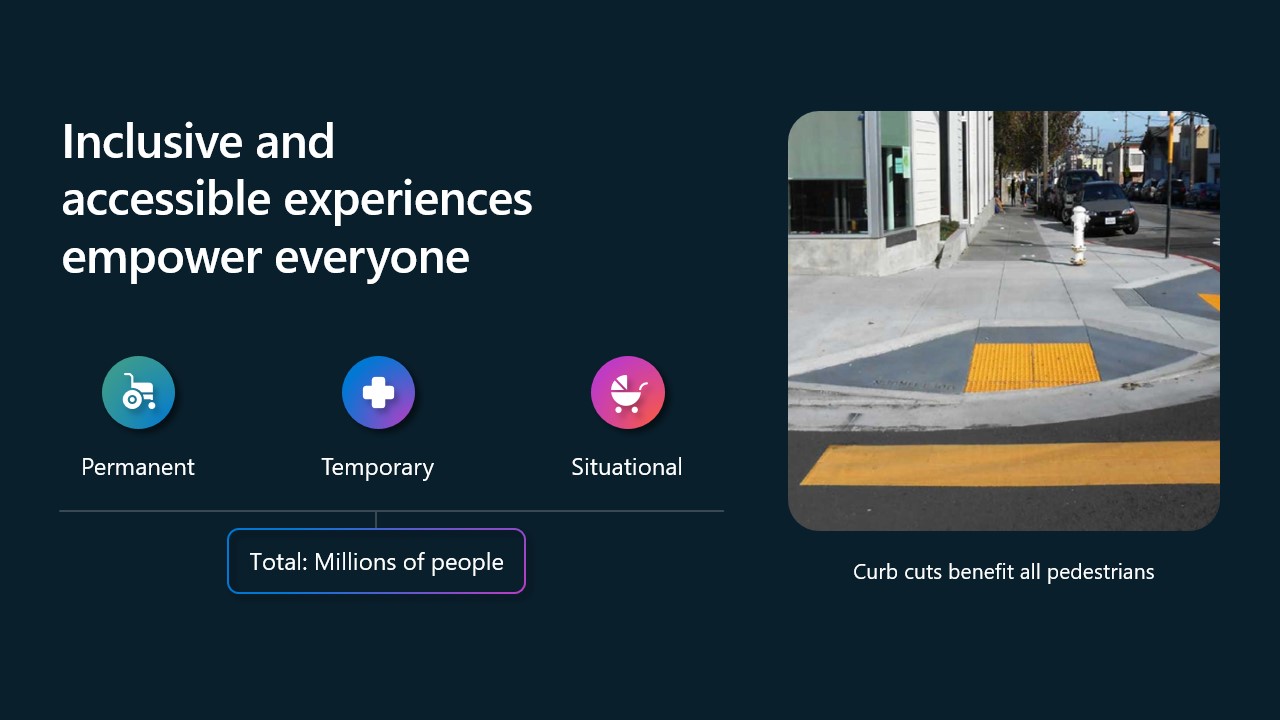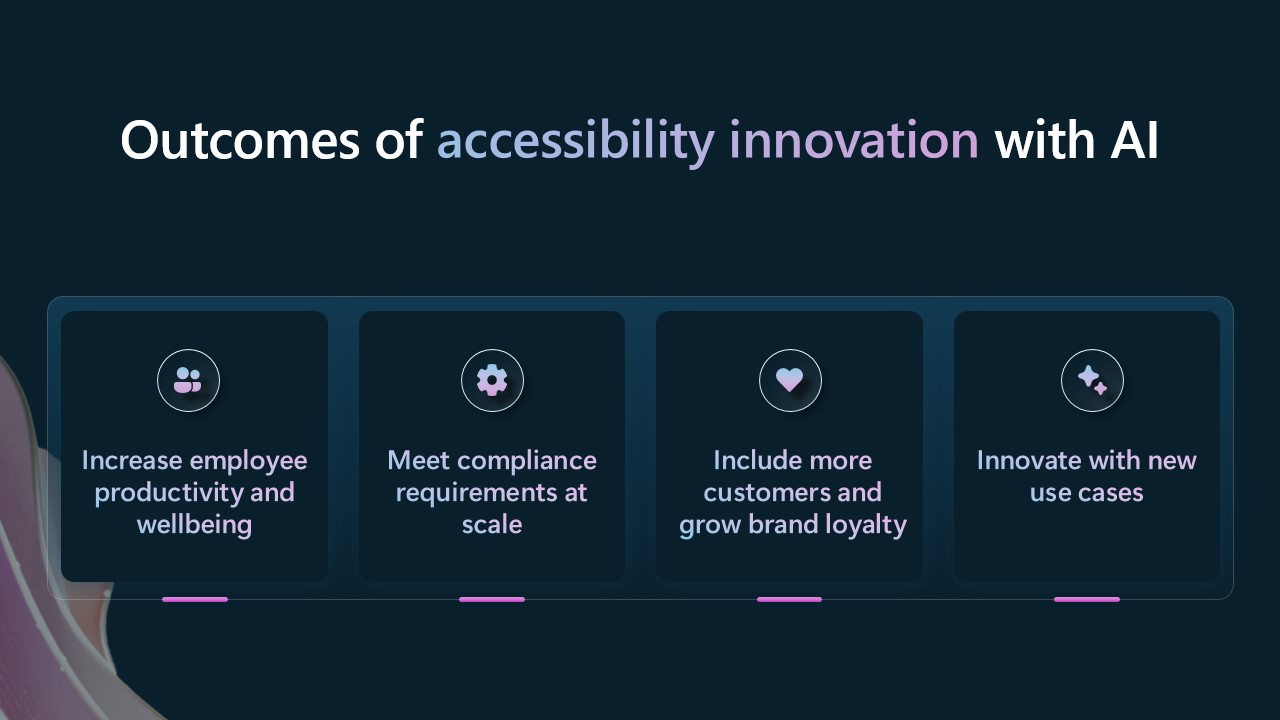As we celebrate innovation in accessibility at Microsoft’s Ability Summit 2025, we invite you to explore how Azure AI can enhance accessibility in your products and services. The future isn’t just about removing barriers—it’s about building a world where everyone moves forward together.
When my wife and I had our first child, I started seeing the world differently. Pushing a stroller through our neighborhood, I quickly realized how much I had taken for granted—sidewalks that suddenly ended, intersections without curb cuts, pathways that were technically walkable but not built for wheels.
It wasn’t just a minor inconvenience. It made me think about my elderly grandmother, who relied on a walker. And my parents, who are active now but won’t always move as easily as they do today. Mobility and accessibility are deeply connected, and for the first time, I saw how infrastructure shapes our daily experiences—whether we notice it or not.
But physical mobility is only part of the equation. In the digital world, there are just as many curbs that need cutting. Websites that don’t work with screen readers. Captions that lag behind real-time speech. AI models that fail to understand diverse voices. These barriers may be invisible to many, but they create real limitations for millions of people.
And just like curb cuts in sidewalks, digital accessibility doesn’t just benefit one group—it makes technology better for everyone. That’s where Azure AI Foundry, Azure OpenAI Service, and the latest innovations in multimodal AI and Responsible AI (RAI) come in—helping organizations cut digital curbs and build a world that works for all.

As we recognize the impact of accessibility innovation at Microsoft’s Ability Summit 2025, we encourage you to explore how AI can drive greater inclusion in your products and services.
The goal isn’t just to eliminate obstacles—it’s to design a world where everyone moves forward together. Here are some of my favorite real-world examples.
Real-world impact: How Azure AI is cutting digital curbs
The curb cuts of digital accessibility didn’t start with generative AI—Microsoft has been building inclusive technologies for decades. From early screen readers to speech-to-text innovations, AI has long played a pivotal role in expanding access. But now, we’re going even bigger.
Bridging the mental health gap with AI-powered conversations
Technology: Azure AI
Mental health support is a growing necessity worldwide, but in Kenya, where there are only about 100 psychiatrists for a population of 50 million, access to professional care is extremely limited. Financial and cultural barriers often keep people from seeking the help they need.
Kenya Red Cross saw an opportunity to bridge this gap using Azure AI-powered chatbots. In partnership with Pathways Technologies, they developed Chat Care, an AI-based mental health assistant that provides guidance, emotional support, and referrals—all in English and Swahili.
This isn’t just a chatbot; it’s a lifeline for people who may otherwise suffer in silence. Chat Care allows users to start conversations about their mental health in a low-pressure, anonymous way, reducing stigma and offering resources that are accessible 24/7. It can suggest breathing exercises, gratitude practices, and in-person services, all tailored to the user’s responses.
And for people who are deaf, hard of hearing, or unable to speak on the phone, Chat Care offers text-based support, ensuring mental health services are available to everyone, regardless of ability or circumstance.
Improving AI speech recognition for non-standard speech
Technology: Azure AI Speech x UIUC Partnership
Voice recognition technology often struggles to understand people with non-standard speech patterns, making it harder for individuals with conditions like cerebral palsy or amyotrophic lateral sclerosis (ALS) to interact with AI-powered experiences.
To solve this, Microsoft partnered with the University of Illinois Urbana-Champaign and fellow tech leaders to build the Speech Accessibility Project—a research initiative to train AI models that recognize diverse speech patterns.
By integrating this breakthrough into Azure AI Speech, Microsoft is ensuring that AI-powered voice technology works for everyone, making digital experiences more inclusive across industries.
Making AI more accessible from the ground up
Technology: Azure AI Foundry
With Azure AI Foundry, Microsoft has embedded accessibility into the AI development lifecycle itself. By partnering with EY, the Azure AI Foundry now empowers neurodivergent customers, and features improved usability, reducing cognitive overload and improving navigation for all people.
In 2024, Azure AI Foundry reached a milestone for usability, reflecting feedback from people with disabilities that helped improve the platform. The updates included:
- Grouping notifications and deployment errors to reduce cognitive overload.
- Ensuring screen readers provide structured, easy-to-follow AI workflows.
- Enhancing keyboard navigation for people who rely on shortcuts over mouse input.
This is a prime example of why accessibility is about building better, more intuitive technology for everyone.
Making accessible AI work for agents
Technology: Computer-Using Agent (CUA)
Microsoft’s Computer-Using Agent (CUA) in Azure AI Foundry enables AI-powered automation of digital interactions, making software more accessible for people with limited mobility or dexterity. By allowing CUA to navigate interfaces, complete multi-step tasks, and execute actions through natural language commands, it reduces reliance on traditional keyboard and mouse inputs.
This breakthrough enhances digital accessibility, empowering people who use any kind of assistive technology. As CUA dynamically interprets UI elements, it makes it easier to navigate applications and workflows.
Hope, action, and moving forward together with Azure AI
There are days when it feels like progress is slow. That accessibility, whether physical or digital, takes too long to improve. But then I think about something as simple as the sidewalks at my cross streets.
Not that long ago, they were completely inaccessible. But after making a call, filing a report, and pushing the issue, those sidewalks finally got curb cuts just in time for the birth of our second child. It was a small fix in the grand scheme of things, but it made a real difference.
The truth is, sometimes it just takes someone noticing the problem and taking action. But I also know I say that from a place of privilege—I had the time, the resources, and the ability to advocate for that change. Many people don’t. That’s why it’s so important that we build accessibility into our systems from the start—so that no one has to fight for the basics.
With Azure AI Foundry, organizations can now scale accessibility faster than ever, making the digital world more navigable, usable, and welcoming to all. The curb cuts are being built—and the future of accessibility is wide open.

Join us at Ability Summit 2025
As we celebrate innovation at Microsoft’s Ability Summit 2025, we invite you to explore how AI can enhance accessibility in your products and services.
The future isn’t just about removing barriers—it’s about building a world where everyone moves forward together.

